
From Product Candidate to Product: The Road to Commercialization in Regenerative Medicine
Although few cell therapies are currently available to patients, Cell Therapy Group estimates that there are 37 cell therapies currently in late stage clinical development. [i] Many of these are likely to be positioned for FDA review in the next few years. However, as the industry makes important progress in clinical research, several aspects of Cell Therapy development continue to present considerable challenges for large scale commercialization.
One current challenge is that the production of cell therapies typically carries higher manufacturing risks than the production of small molecule pharmaceuticals, especially as production is ramped up to meet broader demand. Most cell therapies present significant risks of manufacturing errors or contamination issues, which can stop production entirely or affect efficacy and patient outcomes. Most cell therapies also have a relatively short shelf life, which can put additional pressure on production and distribution schedules. The cell manufacturing process must also meet both FDA regulations and the requirements of a successful business model. Companies developing cell therapies must identify the optimal strategies to transition to commercialization without compromising quality.
Autologous vs. allogeneic therapy manufacturing
An estimated 54% of cell therapies now in late stage development are autologous and the remaining are allogeneic. [ii] Autologous therapies involve taking a cell sample from a patient, manipulating or expanding those cells and then administering the final product back to the same patient for treatment. Allogeneic cell therapies derive treatments or doses for multiple patients from the cells of a single donor. While manufacturing allogeneic therapies can be more efficient for companies because multiple batches can be created from a cell sample, They may not be as safe as autologous therapies which use a patient’s own cells, virtually eliminating the risk of rejection. These types of therapies can carry the risk of graft-versus-host disease, which occurs when the donor’s transplanted stem cells attack the recipient’s body tissues. An allogeneic transplant also has the potential to transfer pathogens that cause disease or illness from a donor to a recipient.
Product tracking and quality control
When producing cell therapies at a high volume, it is critical that every step of the manufacturing process be executed with the highest levels of quality and precision to avoid risks such as cross-contamination. Aastrom Biosciences, which has an autologous Cell Therapy called ixmyelocel-T in phase 2b development for ischemic dilated cardiomyopathy, is addressing these challenges through the use of a closed, automated system for cell processing. Importantly, the processes developed at Aastrom are also designed to be scaled out quickly to increase the number of batches manufactured, making it possible to meet demand following regulatory approval.
Aastrom has successfully implemented an automated tracking system for each disposable bioreactor cassette used in the production process. Each cassette stores the patient’s cells throughout the production of ixmyelocel-T. This tracking system captures information about the patient’s cell sample as it goes through each stage of processing. All lab instruments that come in contact with cell cassette send continuous updates to an electronic memory device on the cassette. In this way, the device can help to significantly reduce the risk of operator errors while also allowing production to continue in the event of an equipment failure or power loss.
Aastrom is now designing a more comprehensive automated product manufacturing tracking system referred to as the Manufacturing Execution System (MES). The MES will contain multiple software programs to monitor all manufacturing steps, manage an electronic batch record system and execute certain processing and tracking procedures. Many aspects of quality control testing at Aastrom are currently managed manually, which is effective, but could slow down production when output volume increases with commercialization. The MES will be an important part of Aastrom’s future automated quality control testing system by capturing quality information and approving processes without manual data entry.
Post-culture processing
Autologous and allogeneic cell therapies often need to undergo post-culture manufacturing steps such as removing process residuals or formulating the cells for delivery before they are suitable for patient administration. Post-culture processing can be relatively time consuming and subject to increased risk of error, contamination and excessive holding times. Transfers in this phase can result in cell loss or decreased cell viability.
Companies transitioning to the commercialization stage should consider reducing the number of steps in post-culture processing to make manufacturing more efficient and reduce the risk of error. Aastrom is using an automated system to complete two post-culture processing steps (removing the culture medium and washing the cells) that significantly reduces cell loss.
Key to success: simplicity
To support commercialization, Cell Therapy manufacturing systems should be as simple as possible and be automated to accommodate high volume throughput without compromising quality. In some cases, companies may need to partner with a contract manufacturing organization (CMO) to expand production. A simpler system can also make the CMO training process easier. Though automation can be more challenging with autologous therapies, it can help to improve consistency and reliability in processing with single-use disposables. A continuing effort to identify the most effective manufacturing procedures will be essential to realize the full promise of cellular therapies as they are positioned for large scale use.
Footnotes
-
1. Buckler, L J.D., Razvi, E. “Cellular Therapy Wave Finally Cresting.” Genetic Engineering & Biotechnology News.2012;32(19)
-
2. Buckler, L J.D., Razvi, E. “Cellular Therapy Wave Finally Cresting.” Genetic Engineering & Biotechnology News. 2012;32(19)

